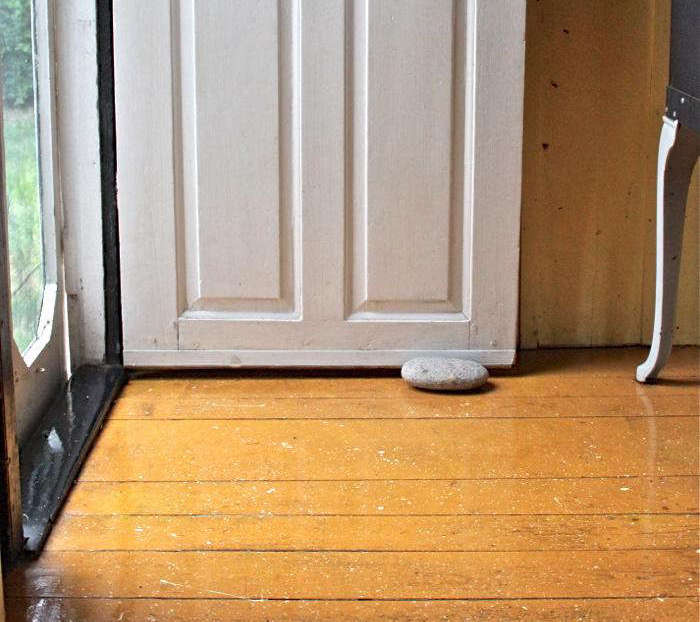Over the years I’ve hired many painters—from Task Rabbit amateurs to professional tradesmen—for both interior and exterior projects. Yet for all my experience, I still feel like hiring a good painter is a crap-shoot, that I’m no closer to discovering that secret formula that guarantees a great paint job every time. Based on the number of friends who painstakingly share their own painting horror stories, I’m not alone. Luckily for me, I have finally found a great painting contractor, Nigel Costolloe, owner of Catchlight Painting, in Newton, MA. I wish I could say that I came to Nigel due to my superior knowledge of how to sleuth out and hire great painters. Alas he was the guy I called to fix a job-gone-wrong.
Having now successfully completed several exterior and interior projects on my home, the Catchlight team feels like old friends. So I asked Nigel if there really was a way to guarantee that you hire the right painter. He admitted that when it comes to paint contractors, “it’s a bit of the Wild West.” With no formal training or licensing, anyone with a brush can be a painter. But he went on, there are tell-tail signs of a reputable company and important steps that a homeowner can take to ensure that they hire the best painter for their project. Here is what Nigel recommends:
N.B.: Featured photograph courtesy of The New Road Residence.

Step 1: Start with online research.
A good place to start is to ask a trusted friend or general contractor for a recommendation. For my Cape Cod cottage, I found a great painter who painted the homes of my cousin, a contractor; my aunt, an architect; and my other aunt, who is even more picky than the other two. Prior to this painter however, I had hired a guy based on the recommendation of another friend with a similar historic house. Disaster! The paint job didn’t last two years. That’s why even with a recommendation, Nigel suggests you do some online research. Find out if others agree with your friend’s or relative’s assessment of the painter’s work, or if the contractor has experience working on your type of house. (When it comes to painting, modern and vintage homes are whole different animals.)

Search for online reviews.
Both Google and Yelp list (mostly) independent reviews from real costumers. Yes, it’s possible to “game” them, but Nigel has some tips on what to look for:
- Detailed—versus general or vague—reviews. The former indicates that the person writing the review has actual experience working with the company. Furthermore their thorough descriptions will give more insight into the company’s practices and job performance.
- Reviews from multiple sites. Inconsistent reviews from one site to another can indicate that the reviews may have been manipulated.
- “More reviews not recommended by Yelp.” Yelp prioritizes posts from its frequent reviews. Reviews by the non-habitual (a.k.a. “not recommended”) reviewers, can be found buried at the bottom of the featured reviews. These comments, from clients often motivated by a really good or bad experience, can give you even more valuable feedback.
- Replies from the company owner. For a bad review, you certainly want to see a response that explains what may have gone wrong. But even just a “thank you” on a good review indicates superior customer service.
Also note:
- If a company has no online review profile, this can be a red flag.
- Beware of brokerage sites which offer to make referrals. Often these companies make money based on the number of referrals, not the jobs booked, so their recommendations may be based on little more than a background check on the owner.

Visit the company’s website.
Nigel asserts that much can be gleaned from a contractor’s website. Look for the following:
- Portfolio of past projects. Look for photos of many different projects, indicating more experience. Images should include close-ups of detailed work. Progress shots will also give you an idea of the company’s process. Look for evidence that the crew uses proper equipment and follows safety protocols. Especially for people with older homes that often have intricate detailing or lead paint, look for pictures that demonstrate that the company has extensive experience working with them.
- Crew page with company bios, or at least images of the crew working on site. These will help you gauge workers’ level of experience, and give you some idea of who will be showing up at your house.
- Blog. Blog articles are one indicator that the contractor takes pride in their business and work. Look for original postings by the owner that show actual projects by the company. Boilerplate articles are just a sales job.
- Information on how long the company has been in business.
- Professional affiliations, awards.
- Information on Lead Paint Safety.
Google the company’s owner/founder.
- Naturally you do not want to see any mention of lawsuits. You do want to see a proven record of past work, announcements of professional affiliates, perhaps even an interview for a the local paper or trade magazine.
Look up the company on the EPA’s Lead Paint Certified database.
If your house was built before 1978, chances are you have lead paint. If so, it is important to educate yourself about current RRP (Renovation, Repair and Paint) laws via the EPA’s website. You can also look up the name of the contractor on this site to see if they are certified to handle lead paint.

Step 2: Interview the painter at the job site.
Once you’ve narrowed a list of semi-finalists through your thorough online research, schedule a number* of appointments to receive an estimate. Think of these meetings as interviews. Nigel stresses that this is your best opportunity not only to get a sense of the company, but also to communicate your expectations, so make sure you are there when they visit.
*Note: Nigel does not recommend a certain minimum or maximum number of bids. Instead he recommends letting your research be your guide. If you really like five contractors, speak to five. If only two, that may be enough to find the right fit. You can always go back and get more later.
Look for the following indicators of a reputable company.
- First and foremost look for a love of craft. Does the company owner “geek out” about the chemistry of paint? Do they lovingly volunteer stories of past pet projects? All these things indicate that the company owner takes personal pride in the work his or her company does.
- Do they spend a lot of time walking around the property with you? Do they point out potential problem areas and ask detailed questions about your expectations? The more time a contractor spends with you and your home, the more thorough both your and his/her understanding of the project will be and the more accurate their estimate.
- Do they make recommendations that are specific to your house? Do they find things that you may have overlooked such as paint build-up or problems such as excessive moisture that may compromise the job? These observations not only demonstrate knowledge but also serve to educate you. If your project is detailed or involves lead paint, you’ll want to hear specifics about process, protection, and cleanup, not general statements.

Request a detailed proposal.
For big jobs, bids can vary by tens of thousands of dollars. Chances are that lower bids mean less prep. Or they could use cheaper materials, or they may not follow time-consuming safety protocol, or don’t pay their workers a living wage. On the other end of the spectrum, some painters may jack up the price based on your zip code or even because they don’t really need or want your business. In order to truly compare apples to apples, i.e. really understand what you money is buying, you need a detailed proposal from all your contractors.
Another reason to request a delineated bid is simply to have in writing everything you discussed in the interview. With so many interviews, you may forget who said what. Ask him or her to include the following:
- Detailed descriptions of work to be performed broken down by area and phase. For example, for exteriors the time/methods/materials to prep and paint siding, trim, porches, windows (areas) may be different. Ask for separate and detailed descriptions of the proposed prep work (including mention of any sanding, scrapping, grinding, caulking, repair) and paint (number of coats of primer and finish) for each of these areas. For interiors you want the work separated by room or project area (stairs, doors, floors, etc).
- Quantities: Ask for the estimated number of hours or materials spent on each separate area/phase. For example, how much time do they expect to spend prepping the trim versus the siding. By requesting the estimated hours spent on each aspect of the job, you can see how each contractor expects to allocate their time.
- Rates: The cost per each individual quantity, i.e. rate per hour or cost per material. These numbers can provide a window into quality. For example is one contractor paying his workers a lot less? They may be less skilled. Is one recommending ten cans of paint, while another five? Are the prices per can of paint different? All these details will help you make the best decision for your budget.
- Type of paint recommended and number of coats. Whatever they told you in answer to your questions about paint above, ask them to reiterate that info in the proposal.
Ask for insurance information.
Request the name and contact of their insurer. Even if the contractor presents you with a certificate of insurance, they could call right after your meeting and cancel. Call the insurer yourself to make sure that their insurance is up to date.
Above: I attempted to paint my detailed pantry myself for a Remodelista post. Truth be told, it was so time-consuming that I was able to only apply one coat to the outsides of just one side of the room. To finish the painstaking work, including on the interior cabinets, I called on Catchlight.
Step 3: Review and compare each proposal.
Nigel notes that there are two very important reasons why you want a detailed proposal. The first, as described above, is so you can make an informed decision about what exactly you will be getting for your money. The second is because the proposal will act as a road map for the project, to which not only you, but also the crew, can refer. For example, at the end of each day Nigel’s designated foreperson checked in with me to review the progress. He or she was able to tell me that this area was going faster or slower than the bid indicated and ask me if/how we wanted to adjust. In other words the bids served as a point of reference that facilitated mutual expectations and clear communication throughout the entire project.

Look for line item details with corresponding hours and rates.
A good bid proposal will include detailed descriptions of the start-to-finish work to be performed, including how they will protect the property, how they will clean and prep the surfaces, how they will prime and then paint, and finally, how they will clean up. Look for the following specifics:
- A thorough description of how they plan to protect you and your property, including protective tarps or covers, taping, etc. Exterior work can involve falling debris and/or lead paint (both scraping and sanding release lead into the atmosphere). Interior work can result in a lot of dust from sanding or fumes if you’re using oil-based paint.
- A delineation of how they will clean the surfaces to be painted. You want to make sure they wash off dirt and mildew before they paint.
- A detailed breakdown of how they plan to prep each area of your job, including any and all of the following: scraping, sanding, grinding, caulking, repair. Make sure they also include an estimate for the number of hours and rate per hour associated with each area. Why such detail? Again, line-item descriptions will help you compare apples to apples. For example, if Painter 1 has a total prep bid that is twice as much as Painter 2, you might go with Painter 2. But if you can see that Painter 1 plans to spend three times the hours prepping the job, you may decide that you’re getting more for your money with Painter 1.
- A comprehensive account of their painting plan, i.e. number of coats per surface for both primer and paint.
- Cost of materials associated with each phase of the project. Again one painter may budget for five cans of paint for one section, another ten. Or one may be using better paint.
- An account of daily cleanup, as well cleanup once the project is finished. This is especially important if you have lead paint.
- A portable toilet (for exterior work). I had to ask Nigel if he was serious about this one really being that important. It is. First, he noted that it is required by law if your house has lead paint. Otherwise the crew will have to decontaminate themselves every time they enter your home. Even if you don’t have lead paint, a porta potty is a good idea as it demonstrates a certain amount of respect for your property as well as for their workers.
- A description of the company’s warranty. Make sure it includes labor as well as paint and number of years covered.
- An option for carpentry or other structural work.
- Also read any fine print about what they are not liable for. If this section is longer than the bid, it may not be a good sign.
After reviewing each bid, feel free to call and ask more questions.

Step 4: Work with your painter to accommodate your budget.
One note about negotiating the price. A lot of people experience sticker shock when getting a paint estimate. As a result it’s tempting to ask the painter to drop their price or meet another’s bid. Nigel says that, if through your thorough online research and bidding process, you are confident that you are working with a reputable company, then you can be confident that the price they have quoted is an accurate representation of the cost. If this is the case, then any reduction in price will mean that the contractor has to cut corners somewhere. If a proposal is beyond your budget, Nigel notes that it is better to work with the company to decide options that might better fit your budget. Perhaps you can get away with less prep on the back of the house, or maybe you can put off part of the project for another time. Here again, if you have a detailed proposal you and your painter can work with specifics, so you and their workers will know what to expect.
N.B.: This is part 1 of Justine’s guide to choosing the right painter for the job. Make sure to check out part 2: Expert Advice: 13 Questions to Ask a Painter Before You Hire the One.
Once you’ve hired a great painter, now you can choose your color:
- The Unbuttoned Palette: Sexy Paint Colors from Paris
- A Line of Subtle Paint Colors from New Zealand
- 7 Favorites: British Boutique Paint Companies
Frequently asked questions
What should I look for when hiring a professional painter for my house?
When hiring a painter, look for someone who has experience in painting houses, is licensed and insured, provides a written estimate, has references, and uses high-quality materials.
How do I find a professional painter for my house?
You can find a professional painter for your house by asking for recommendations from friends or family members, searching online or in the phone book, or by contacting a local painting association or contractor's association.
How do I choose the right paint color for my house?
Choosing the right paint color for your house can depend on factors such as the style and architecture of the house, the existing color scheme, and personal preferences. It's best to get samples of different colors and test them in different lighting to make the best decision.
How much should I budget for a professional house painter?
The cost of hiring a professional house painter can vary based on factors such as the size and complexity of the project, the quality of materials used, and the location of the house. It's best to get a written estimate from the painter before starting the project to determine the costs.
What preparation work should I do before the painter arrives?
Before the painter arrives, you should clear the area around the walls to be painted, remove any furniture or decor, and cover floors and furniture with drop cloths or plastic to protect them from paint splatters.






Have a Question or Comment About This Post?
Join the conversation